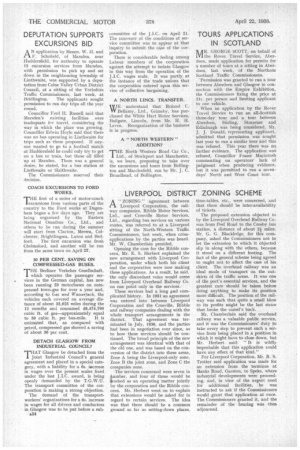LIVERPOOL DISTRICT ZONING SCHEME
Page 64

If you've noticed an error in this article please click here to report it so we can fix it.
AZONING " agreement between Liverpool Corporation, the railway companies, Ribble Motor Services, Ltd., and Crossrille Motor Services, Ltd., regarding bus services on various routes, was referred to at a Liverpool sitting of the North-Western Traffic Commissioners, last week, when crossapplications by the parties was heard. Mr. W. Chamberlain presided,
Opening the case for the Ribble concern, Mr. E. S. Herbert explained the new arrangement with Liverpool Corporation, under which both his client and the corporation were now making these applications. As a result, he said, the only discordant voice would come from Liverpool Overhead Railway Co. on one point only in the services.
These services had a long ,p.nd complicated history. In 1931 an agreement was entered into between Liverpool Corporation and the Crosville, Ribble and railway companies dealing with the whole transport arrangements in the district. That agreement was terminated in July, 1936, and the parties had been in negotiation ever since, as to how these services should be continued. The broad principle of the new arrangement was identical with that of the old one, and was based on the conversion of the district into three areas, Zone A being the Liverpool-only zone, Zone B the joint zone, and Zone C the companies zone.
The services concerned were seven in tiumber, and four of those would be ivorked as an operating matter jointly by the corporation and the Ribble concern. Mr. Herbert went on to explain that extensions would be asked for in regard to certain services, The idea was that there should be a common ground so far as setting-down places, time-tables, etc., were concerned, and that there should be inter-availability of tickets.
The proposed extension objected to by the Liverpool Overhead Railway Co. was from Peel Road to the Crosby bus station, a distance of about 24 miles. Mr. G. G. BIackIedge, for this company, asked the Commissioners not to let the extension to which it objected slip in along with the others, because it stood on a different footing. The fact of the general scheme being agreed to ought not to affect the case of his client. The overhead railway was an ideal mode of transport on the outskirts ef the traffic areas. It was one of the port's essential services, and the greatest care should be taken before doing anything to make its position more difficult. The position of the railway was such that quite a small blow to its profits might be the last straw that broke the camel's back, Mr. Chamberlain said the overhead railway was a valuable public service, and it was the Commissioners' duty to take every step to prevent such a service from being placed in a position in which it might have to close down, but Mr. Herbert said: " It is wildly improbable that this application could have any effect of that kind."
For Liverpool Corporation, Mr. R. S. Trotter said application was made for an extension from the terminus at Banks Road, Garston, to Speke, where industrial developments were proceeding, and, in view of the urgent need for additional facilities, he was instructed to ask if the Commissioners would grant that application at once. The Commissioners granted it, and the remainder of the hearing was then adjourned.


































































































